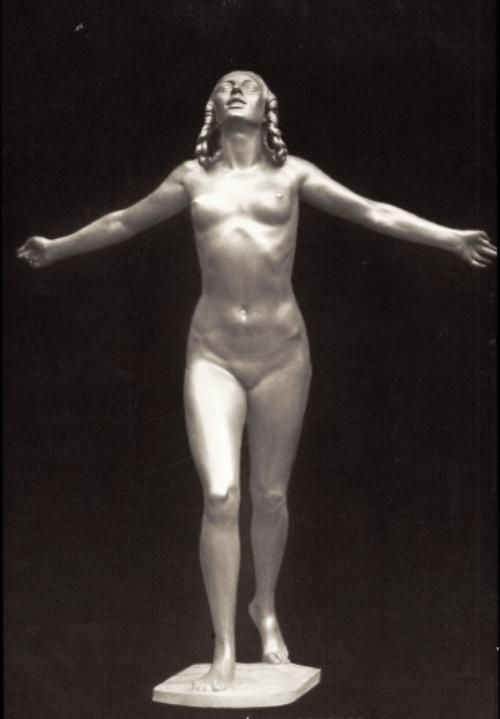Biography from German Art Gallery
Ernst Seger (1865 1939), born in Neurode (Nowa Ruda, now Poland), studied sculpturing from 1884 at the Kunstschule in Breslau under Robert Härtel. From 1886 he worked in the Atelier of Christian Behrens, where he created the Eichendorff-Memorial for the Silezian City of Neisse. From 1893 to 1894 Seger stayed in Paris where he worked in the atelier of Auguste Rodin. However, Seger finally chose a ‘Jugenstill’ and a more ‘naturalistic’ or ‘Neuklassizismus’ style. His sculptures, modelled like the Greek antiques, were later greatly admired by the National Socialists.
At the end of 1894 Ernst Seger went back to Berlin, founded his own atelier and created the Kaiser Wilhelm I memorial for the Silesian City of Glatz. In 1897 Seger created the sculpture ‘Jugend’ (‘Youth’), which was displayed at the ‘Große Berliner Kunstausstellung’ in 1898, at the ‘Große Berliner Kunstausstellung’ in 1899, at the ‘Münchener Glaspalast Ausstellung’ in 1899 and at the ‘Münchener Glaspalast Ausstellung’ in 1908. As a sculptor Seger regarded this as his first relevant work, his breakthrough. A copy of the sculpture in bronze, 1.60 metres high, was placed in the ‘Scheitniger Park’ in Breslau (now Wroclaw). In 1898 Segers ‘Diana’, the Roman Goddess of the Hunt, the Moon and Childbirth, was unvealed in Park Szczytnicki, Breslau, Polen (earlier ‘Schneitniger Park’). Until 1945 the sculpture stayed in the Schneitniger Park, Breslau. This part of the park is still called ’Dianagarten’.

After the turn of the century the elegant female dancers and nudes by Seger gained great popularity. In 1905 Ernst Seger created – together with the sculptor Bernhard Sehring – the ‘Bismarck Brunnen’ (‘Bismarck Fountain’) in Breslau. This memorial-fountain (which still exists) represents the allegories ‘Kampf’ and ‘Sieg’ (‘Battle and Victory’). Seger’s ‘Verwundete Amazone’ (‘Wounded Amazon’), displayed at the Grosse Münchner Kunstausstellung in the Glaspalast in 1908, was placed in the garden of the ‘Kaufhauses Wertheim’ in Berlin. In the same year he was appointed as a professor. Seger’s marble sculpture ‘Kypris’, created in 1916, was placed in the Alten Nationalgalerie in Berlin. In 1925 the City of Berlin acquired his sculpture ‘Anbetung’ and placed it at the Johannaplatz. ‘Storchenbrunnen’ (‘Stork-fountain’), was placed in 1931 at the Adolf-Scheidt-Platz in Berlin. In 1935 the American newspaper publisher William Randolph Hearst bought Seger’s sleeping ‘Ganymede’.
During the Third Reich Ernst Seger was commissioned numerous Hitler busts; in 1933 one of them was placed in the hall of honour at the ‘Internationale Funkausstellung’ (‘German Radio Exposition’) in Berlin. At the turn of the year 1933/1934 he created a relief of ‘Hindenburg and Hitler’. Despite Seger’s popularity and fame his life-size ‘Am Ziel’ (‘At the Finish’) which had stood at the edge of the Berlin Wannsee since 1934, was melted down in 1940, as bronze was needed for the war-industry (‘Am Ziel’, 190 cm high, was displayed for the first time at the exhibition ‘Hundert Jahre Berliner Kunst’, 1929, organized by the Verein Berliner Künstler).
At the Great German Art Exhibitions Seger was, until his death in 1939, represented with seven sculptures, including ‘Sportlerin’. Adolf Hitler bought ‘Lebenskraft’ (‘Vitality’) for 15,000 RM, as well as ‘Gewichtheber’ (‘Weightlifter’) and ‘Kraftgefühl’ (‘Feeling of Power’).
Ernst Seger died in August 1939 in Berlin. Seger’s gravestone at the Südwestkirchhof Stahnsdorf bears his marble relief ‘Der Bildhouwer und sein Gedanken’, which was displayed at the Grosse Berliner Kunstausstellung 1921.
Germany does not need women who can dance beautifully at five o’clock teas, but women who have given proof of their health through accomplishments in the field of sports… The javelin and diving-board are more useful than lipstick in promoting health,” Frankfurter Zeitung 1937.
The Aryan Ideal
The cult-like fascination with the naked body was already very popular in the early part of the 20th century. This trend strengthened in intensity when the Nazis garnered power. The ideas of Friedrich Ludwig Jahn, founder of the German Gymnastics Association in the beginning of the 19th century, were widely propagated. Painting and sculpting celebrated the naked body in ecstatic poses. A new feeling for the body had emerged; the Aryan body. ‘He restored to her proper place in life the German woman and mother who had been debased as an instrument of concupiscence by medieval asceticism, and placed her slender, naked body in its tree-like beauty as a symbol of grace and fertility amidst the budding and growing life of the German landscape’. The SS magazine Das Schwarze Korps (The Black Corps) advertised, ‘… we want a strong and joyful affirmation of body awareness, because we need it to build a strong and self-confident race’. Nudity was seen partly as a means of encouraging the ‘health of the race’.
Source Article from http://www.renegadetribune.com/sculptures-respected-german-artist-ernst-seger/
 RSS Feed
RSS Feed















 September 29th, 2017
September 29th, 2017  Awake Goy
Awake Goy 
 Posted in
Posted in  Tags:
Tags: 













